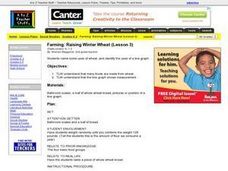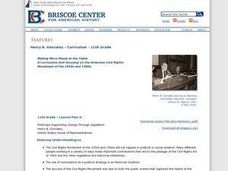Briscoe Center for American History
Mary Maverick and Texas History - Part 2
To conclude their investigation of the life of Mary Maverick and to demonstrate their ability to analyze primary source documents, groups use the SOAPS questioning method to examine Maverick's account of events in early Texas history.
Briscoe Center for American History
Mary Maverick and Texas History - Part 1
What's the difference between a diary and a memoir? Young historians explore the ramifications of this question as they learn how to use primary source materials to gain an understanding of life on the Texas frontier.
Briscoe Center for American History
Applying the SOAPS Method of Analyzing Historical Documents
Young historians use the SOAPS (Speaker, Occasion, Audience, Purpose, Subject) method of questioning to determine the historical value of primary source documents. The third in a series of five lessons that model for learners how...
Curated OER
Genocide-Holocaust
Twelfth graders gain insight and perspective as to how and why the Holocaust occured. They explain why the specific groups were targeted, and complete a brief paragraph about what it would have been like to live during this era.
Curated OER
Memories of School Days
Students interview, record, and retell school stories of a family member. They research, document, and describe how schools have changed over time.
Curated OER
Women in Progressive Era
Learners study the Progressive Era. They identify the important people, places, and evens of the Era and determine how women influenced the progressive movement. In addition, they create an article to address issues related to the movement.
Curated OER
Crayon Box-Family Diversity
Learners explore diversity in families. In this social studies lesson, students read the book The Crayon Box That Talked and brainstorm traditions they have with their family. Learners create crayon templates with a sentence about a...
Curated OER
The Study of the Spanish-Speaking People of Texas: Who is Russell Lee?
Students investigate the contributions of the photojournalist Russell Lee. They read a biography of Russell Lee, and create a timeline of Lee's life.
Curated OER
Farming and the Services of a Community (Lesson 5)
Pupils identify different types of farms and services of a community. They use a pretend farm scenerio and a worksheet to distinguish between the different types of farms. They also practice using new vocabulary.
Curated OER
Farming: Seasons on a Wheat Farm (Lesson 4)
Students explain the seasons on a wheat farm. They identify the uses of a grain elevator as well. They use a dry erase board to illustrate the seasons and the grain elevator in operation.
Curated OER
Farming: Natural Resources (Lesson 2)
Students identify the types of natural resources. They explain the difference between weather and climate. They practice using a rain gauge and reading a thermometer.
Curated OER
Helping Hands
Students discuss the needs of senior citizens. They assist them with basic household chores. They gain pride in helping others and reflect in their journals.
Curated OER
The Study of the Spanish-Speaking People of Texas
Students analyze photographs from an historical perspective. They examine photos on the Study of Spanish-Speaking People of Texas website, complete a worksheet, and write an essay.
Curated OER
Producing and Consuming
Second graders make a booklet. In this economics lesson, 2nd graders define producers and consumers. They make an assembly line accordion booklet to demonstrate how producers and consumers work together to make and use goods.
Curated OER
The Louisiana Purchase
Learners take a closer look at Lewis and Clark's expedition. In this Louisiana Purchase lesson plan, students play an interactive game based on the expedition and respond to questions about the game once they finish it.
Curated OER
Farming: Raising Winter Wheat (Lesson 3)
Students identify foods that are made from wheat. They use a line graph to explain measurement. They identify foods from the food groups and explain how temperature, prefcipitation and natural resources affect the growth of wheat.
Curated OER
Colonial Flag
Middle schoolers examine the reasons for and the results of the US Revolutionary War. They watch a PowerPoint presentation to review the immediate results of the war. They design a flag for the newly free colonies.
Curated OER
The Study of the Spanish-Speaking People of Texas: Pictures, Images, and Photographs
Students examine how art is used to make statements about social conditions. They analyze photos by the photojournalist Russell Lee, and complete a worksheet.
Curated OER
Making More Places at the Table
Fifth graders explore the use of primary and secondary source documents. They identify primary and secondary sources. Students investigate individuals that made a difference during the American Civil Rights Movement through the use of...
Curated OER
Making More Places at the Table: The American Civil Rights Movement of the 50's and 60's
Eleventh graders examine the biography of Henry B. Gonzalez. They examine primary source documents from Congressman Gonzalez's personal papers related to his contributions to the Civil Rights Movement.
Curated OER
Trade (Hawai'i)
Learners gain further understanding of the diversities of trade and the cultural impact of the trade items. Students evaluate and analyze trade items and use this knowledge to make sound trade decisions. Learners describe and analyze the...
Curated OER
Tribal Sovereignty Mock Trial
Students discuss the issue of tribal/native nation sovereignty. They review the Constitution of the U.S. and discuss how it legally provides for sovereign nations. Then they participate in a mock trial of the 1823 Supreme Court Case...
Curated OER
Naper Settlement: Post Activity, Journal Entry
Fourth graders have to place themselves in someone else' shoes through journal writing. They place themselves in someone else' shoes through journal writing. Students write the journal entry to another student in the class or a...






















